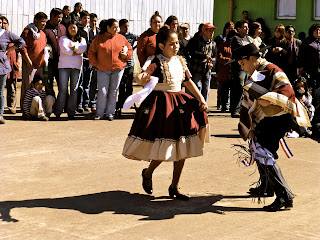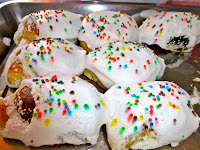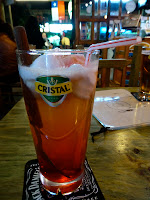Perhaps one of the most anticipated holidays of the year in Chile is Fiestas Patrias, or Dieciocho, which marks the Chilean independence. A holiday I was informed of within my first hours in Chile and one that apparently the Chileans believe they need a whole week to celebrate. And I'm not talking about our US holidays where we celebrate for a day and that's that. The Chileans actually celebrate every single day of the week!
The actual historic days are:
- September 18th (hence dieciocho, eighteen in spanish) which marks the proclamation of the first governing body in Chile--beginning the independence process
- September 19th which is knows as "Día de las glorias del ejercito" or "Day of the glories of the army"--self explanatory.
 Although the actual holiday is only for two days, to my understanding, all work and school in the entire country is closed for an entire week in observation of the independence (with a few exceptions of couse). And boy do the Chileans take advantage of their free time!
Although the actual holiday is only for two days, to my understanding, all work and school in the entire country is closed for an entire week in observation of the independence (with a few exceptions of couse). And boy do the Chileans take advantage of their free time!Chilean flag:
It's actually a law that on this holiday, every public building and chilean home must have a chilean flag flying out in front, hung the correct way and facing the right direction. Failure to comply with this law is punishable by fine. Furthermore, the police actually enforce this law! Apparently they stopped by my host family's home and asked them where their flag was. My host mom who tactically keeps an extra flag by the front door specifically for this scenario, came running out of the house, flag in hand, explaining to the police man that she had a flag out and was just in the process of changing it out for a nicer and newer one. Fine averted.
 La Ramada:
La Ramada:Or "Fonda" as they call it in central Chile is pretty much like a giant Chilean independence party. Its filled with traditional food, dress, music, dance and games. From what I'm told, there are ramadas throughout the entire Independence week.
My school had its own ramada (along with many other festivities) the week before the break, which of course Tía Rebecca was invited to partake in. Each class decorated their classroom, brought in music and food, and many of the kids came in dressed in the traditional Chilean clothes. I celebrated the Ramada with my fifth graders!! (Left- the kids dancing cueca -the national dance- in the classroom. Below- us all siting down for a HUGE lunch)
El mes de las metas:
My host mom described September as "the month of goals". Where there are competitions held throughout the country to see who can make the best ají, empanadas, pévere, etc. in light of Dieciocho.
If all else fails, I can always just stay here and be a judge for the rest of my life ;)
Food:
At this point, I could recite the typical Chilean food in my sleep!
-Empanadas: Cheese, beef or chicken and they can be either baked or fried. (My personal opinion: they are MUCH better fried)
-Pan Dulce or Barritos: A really dense, sweet bread which is typically covered in a merengue-style frosting.
-Asado: Chilean style barbecue containing an assortment of different types of meat. (NOT the US hot dog and hamburgers). When the Chileans have an asado, they're not kidding around! And they LOVEEE their meat during Fiestas Patrias!! They cook the meat on either a parrilla (chilean style grill) or what is pictured below which is a steal (or metal) disc.
-Sopaipillas: The fried dough I've been gawking over since I got here. This stuff will be my demise.
-Mote: Wheat that's been soaked so that it's easy to eat, or in this case, drink. Chileans will put mote in any type of drink and eat it with a spoon. However the most traditional way to drink mote is in Mote con Huesillos. Pictured below, it is a peach drink, (reminds me of a really sweet ice tea) with pieces of peach (huesillo) and mote.
-Terremoto: The evening beverage of choice. It translates to "earthquake" which is exactly what you experience when you stand up after drinking one! Filled with pineapple ice cream, grenadine and whatever mystery liquors the bartender wants to throw in. It's delicious.
-Chicha de manzana: Not pictured because I've never tried it but according to the Chileans this is THE drink of Dieciocho. It is an alcoholic drink made of fermented apples. Still on the to-do list....
 La velada: A town-wide show put on by the students and teachers (and even some private groups) in Perquenco to represent all of the dances that make up and represent Chilean culture. Cueca, the national dance, of course being the main attraction.
La velada: A town-wide show put on by the students and teachers (and even some private groups) in Perquenco to represent all of the dances that make up and represent Chilean culture. Cueca, the national dance, of course being the main attraction.It was here that I learned there are actually TONS of different types of cueca, not just what all of my kids danced at school. There are different variations depending on what part of the country your in. For example, one variation of the cueca is shown above, where the woman dance while balancing a bottle on top of their head. Regardless of the type, the use of the panuelo, or handkerchief, (as their waving to the right) is always a vital part of the cueca.
 But it doesn't stop there... There are all sorts of waltzes and interpretive dances as well. And let's not forget, the baile de los maches.
But it doesn't stop there... There are all sorts of waltzes and interpretive dances as well. And let's not forget, the baile de los maches.
Three weeks ago, some of the girls from my 5th and 6th grade classes knocked on the door to my English classroom and asked to speak to me outside. I left the room to find the professor of dance and culture standing outside waiting for us. The girls excitedly asked me if I wanted to learn how to dance Mapuche and preform a dance with them at the Velada. Not knowing what the hell a Velada was I instantly agreed, eager to learn more about the Mapuche and thrilled that they wanted to invite me into their world.
 It was only later, after the steps were learned and the coreography was memorized that I realized that the Velada was a big, important event of which the entire, and I mean the ENTIRE town attends. Oops!
It was only later, after the steps were learned and the coreography was memorized that I realized that the Velada was a big, important event of which the entire, and I mean the ENTIRE town attends. Oops!
Another blessing in disguise I suppose!! It was incredible to be able to participate in something so important. After all, I've never really been a "sit on the sidelines" kind of girl. Not to mention the entire town got a HUGE kick out of the gringa english teacher dancing mapuche in the traditional dress and attire! (To the left is a photo of our Mapuche group dancing at the Velada.)
 La Cueca:
La Cueca:Perhaps on of the most important things to know about Chilean life in September is the Cueca. As the national dance of Chile, the cueca is meant to represent a man seeking out and courting a woman. The woman keeps a comfortable distance from the man at all times and conceals her face with a panuelo (handkerchief).
 It is typically known as a dance of the countryside, however in September, competitions are held in every town in every region, nation-wide.
It is typically known as a dance of the countryside, however in September, competitions are held in every town in every region, nation-wide.All of my students know how to dance the cueca (as demonstrated in my pictures) and were eager and willing to teach me....
Well, I tried! I guess that's the most important part... however it was wayyyy too much multitasking for me. Remembering the steps, the direction I had to dance, what to do at what part of the song and all while maintaining the circular motion of the panuelo was clearly too much for me to wrap my head around. Oh well. At least I mastered the Mapuche dance!
Traditional Dress:
Another thing I thought was SO cool about this holiday, is that every Chilean has their own set of traditional Chilean clothing reserved for exclusively for Fiestas Patrias.
-The boys wear a hat, white collared shirt under either a jacket or a poncho-like garment, accompanied by special pants, and riding boots ((spurs and all)). It is meant to represent the traditional dress of the Chilean countryman, or huaso.
-The girls all have a pretty, colorful dress, typically decorated with the national flower, that poof out at the bottom so that they can grab it with their left hand while dancing the cueca. (their right hand is occupied by the panuelo).
Chileans of all ages have this traditional dress. From the little kiddies (pictured above, which is my personal favorite) to the high school students, and even most adults take part in this tradition.
 For those that are Mapuche, most choose to show off their traditional Mapuche wear. As you will see to the right, me dressed the part for my Mapuche dance the night of the Velada, I am wearing all of the traditional Mapuche clothing. -Trarilonco, a headpiece made of sliver and colored ribbon that drapes down behind each woman
For those that are Mapuche, most choose to show off their traditional Mapuche wear. As you will see to the right, me dressed the part for my Mapuche dance the night of the Velada, I am wearing all of the traditional Mapuche clothing. -Trarilonco, a headpiece made of sliver and colored ribbon that drapes down behind each woman-Aros, silver earring with mapuche designs (which were given to me as a gift after the Velada)
-Trapelacucha, a silver jewelry piece on the chest of each woman
-A blouse under a black sheet folded and wrapped into a dress and fastened by
-Faja, a beautifully knitted belt
-Echarpe, blanket draped over the shoulders
All of my clothing from that night was authentic Mapuche clothes and jewelry borrowed from the wife of a teacher at my school.
 Los Juegos Criollos:
Los Juegos Criollos: One entire school day was used up to partake in the Creole Games, traditional games and races of Chile. My best way to describe it is like a glorified field day (if any of you remember celebrating field day in elementary school). If you don't, no worries! Most of these games should be familiar....
One entire school day was used up to partake in the Creole Games, traditional games and races of Chile. My best way to describe it is like a glorified field day (if any of you remember celebrating field day in elementary school). If you don't, no worries! Most of these games should be familiar....Tug of war for instance.
Sack race
Three legged race
The funny looking top-contraption you see here is called el trumpo. EVERY Chilean boy has one and they carry it everywhere with them in September. What you have to do is wind a string around it, then wrap the other end around your hand. Then throw it just right and just hard enough onto the ground so that it unwinds from the string and hits the ground spinning like a top. It's SUPER hard but SOOOO rewarding when you finally get a good spin.
El volantín, or kite, is another typical toy of Dieciocho. They are sold in almost every store, and flown everywhere. The last event of the day was exclusively reserved for kite flying. Every child was given a free kite, courtesy of the colegio, and what's more surprising is that each and every child knew how to fly it!
El Desfile:
To conclude MY Fiestas Patrias (as I went traveling the following week), there was a town-wide parade, in which all of the students, bands, sports teams and town groups marched a whopping block and a half, in front of town hall (yellow) and the cultural center (grey).

I was invited to march with my kids and take part in the parade as well, but chose instead to take a step back and watch. This turned out to be a GREAT decision, as I got much more personal satisfaction out of watching them all try and maintain a long enough attention span to march together in a straight line without squirming. It was the most under control I have ever, and probably will ever see them. It was HILARIOUS!
And that's that. I ate, danced, listened, played and participated in all that is Fiestas Patrias (without sticking around for the actual holiday hehe). Personally, I think spending it with my kids was wayyy better anyhow!
Felicitaciones, Chile. ¡Salud!






















